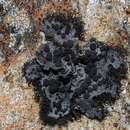en
names in breadcrumbs


Rock tripe is the common name for various lichens of the genus Umbilicaria that grow on rocks.[1] They are widely distributed, including on bare rock in Antarctica, and throughout northern parts of North America such as New England and the Rocky Mountains. They are edible when properly prepared; soaking extensively and boiling with changes of water removes the bitterness and purgative properties.[2][3] They have been used as a famine food in extreme cases when other food sources were unavailable, as by early American northern explorers.[2]
Umbilicaria esculenta is commonly used as a food in Asian cuisine and a restorative medicine in traditional Chinese medicine. It is called shi'er (石耳 "rock ear") in Chinese cuisine, iwatake (岩茸 "rock mushroom") in Japanese cuisine, and seogi (석이(石耳)) or seogibeoseot (석이버섯) in Korean cuisine.
Rock Tripe (seogi) with pine nuts
Lichens of the type eaten by John Franklin's men on their journey back from the Coppermine River
Kishū kumano iwatake tori ("Iwatake mushroom gathering at Kumano in Kishu") by Hiroshige II
{{cite book}}: CS1 maint: others (link) Rock tripe is the common name for various lichens of the genus Umbilicaria that grow on rocks. They are widely distributed, including on bare rock in Antarctica, and throughout northern parts of North America such as New England and the Rocky Mountains. They are edible when properly prepared; soaking extensively and boiling with changes of water removes the bitterness and purgative properties. They have been used as a famine food in extreme cases when other food sources were unavailable, as by early American northern explorers.
Umbilicaria esculenta is commonly used as a food in Asian cuisine and a restorative medicine in traditional Chinese medicine. It is called shi'er (石耳 "rock ear") in Chinese cuisine, iwatake (岩茸 "rock mushroom") in Japanese cuisine, and seogi (석이(石耳)) or seogibeoseot (석이버섯) in Korean cuisine.